This was published 8 years ago
Cycling Konavle Valley, Croatia's valley of bullet holes: APT shore excursion at Dubrovnik
.
By Alison Stewart
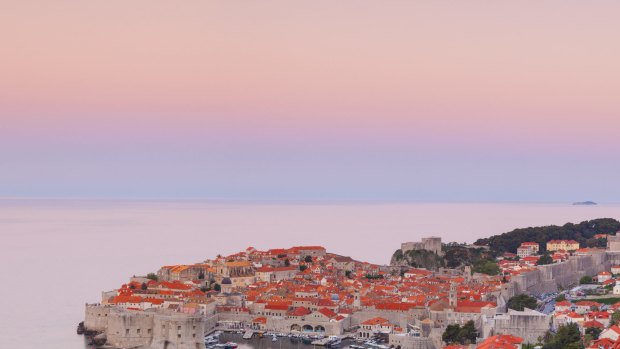
Dubrovnik - the Pearl of the Adriatic.Credit: Doug Pearson
The small farm building in the centre of Croatia's Konavle Valley is pockmarked with bullet holes, a reminder of the savage war of independence that ravaged the Balkan country.
We've paused on our cycle through this 35-kilometre long, 12-kilometre wide fertile vale, tucked into Croatia's pointy end, about 30 kilometres south of Dubrovnik. It's peaceful now, lush with olives, fruit and grapes, and lined with centuries-old trees, but the intensity of our young guide tells us that their war is not forgotten and the peace is something to treasure.
Above us are the karst limestone mountains dividing Croatia from Montenegro to the east and Bosnia and Herzegovina to the north-east. Water from the Ljuta, Konavocica and Kopacica rivers flows from those mountains to nourish the valley but, from 1991 to 1995, waves of fighting surged over them from hostile neighbours as Croatia fought to leave Yugoslavia and become a sovereign country.
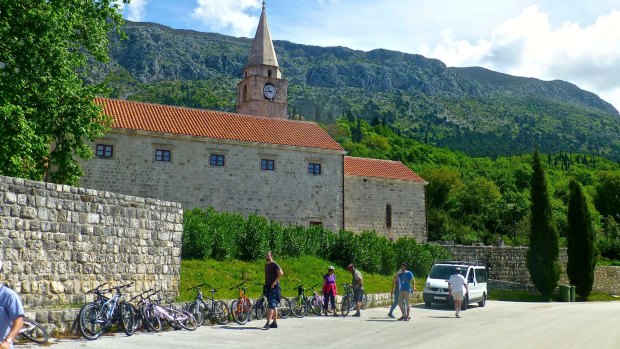
The Franciscan monastery in the Konavle Valley. Credit: Rob Mills
Our three-hour guided cycle is courtesy of APT's Ancient Mediterranean cruise that rock-hops along the Aegean and Adriatic coasts. Our ship has docked off Dubrovnik – Pearl of the Adriatic – and we've chosen the rural cycle from an array of excursions.
These include a tour of Dubrovnik's UNESCO world heritage-listed gothic, renaissance and baroque Old Town (which was bombarded during the war) and a walk around the ancient almost two-kilometre-long city wall with its five forts and 16 towers and bastions, one of Europe's best preserved fortifications.
We'll do those later, finishing with a dinner with shipboard friends in a seafood restaurant off Dubrovnik's limestone-paved main street, the Placa, tucking into grilled whitebait, octopus, scampi, mussels and sardines plucked from the Adriatic.
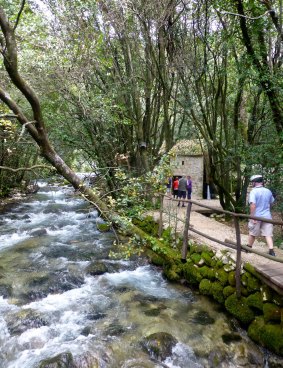
An old water mill on the Ljuta River. Credit: Rob Mills
But first we must earn it. Ivo, our guide, loads us on to the bus, which follows the coastal road along the Dubrovnik Riviera or Zupa Dubrovacka. Picturesque villages, such as Srebreno and Mlini, cling like tiny pearls along luminous bays. The war stunted tourism, so this Dalmatian coast is an unspoilt paradise – a definite prospect for a lazy holiday.
We pass the ancient town of Cavtat and Ivo tells us it was once the Greek town of Epidauros, founded in the 4th century BC, later Epidaurum under the Romans in 228BC. The inhabitants fled north to establish Dubrovnik when their city was invaded.
Our bus turns off the coast to the Konavle Valley, whose name derives from the Latin "canalis", referring to the channels that brought water across the valley to Epidaurum. About 33 villages are scattered across the valley, and we pick up our bikes and guides, Antonella, Pavo and Fravo, in the market town of Gruda.
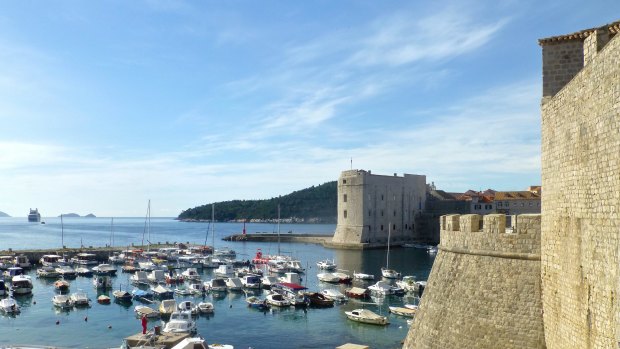
Dubrovnik's city walls. Credit: Alison Stewart
The valley, with its 9500 inhabitants, is a little time capsule, the farms passed down through generations under the patriarchal system. Here they grow olives, garlic, potatoes, fruit, grapes, figs, lavender, herbs and citrus, much of it finding its way into Dubrovnik restaurants.
"It's a heaven on earth," Antonella says. "Sun, clean water, fertile soil, the sea on one side and the mountains on the other. The people do not sell their land here, which is good."
Nor did they give it up to aggressors – the farmers and villagers of the region were hunters, taking up their weapons and fighting fiercely, and ultimately successfully, for their independence.
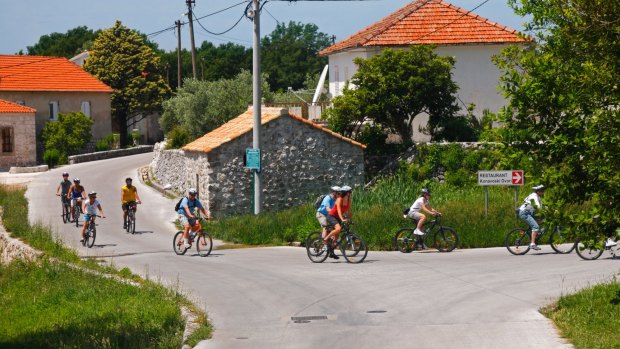
Cycling through Croatia's Konavle Valley.Credit: Alamy
Riding between cypress, pine, olives and figs, the road leads us along waterways up towards the 15th-century renaissance Franciscan monastery in the valley town of Pridvorje. It's closed, so we can't appreciate its rich treasury of sacred art, including a beautiful late gothic crucifix, but it's good to draw breath under a massive plane tree.
Above us is the highest mountain in the range, Mount Snijeznica (1234 metres), with its excellent hiking and mountain biking trails. Around us purple irises glow between almond and fruit trees.
Konavle's rich heritage is evident in the system of water mills and stamp mills that were built on the Ljuta (Angry) River at the beginning of the 15th century. The mill system was critical for the region's economy, with grain and olives pressed, as well as sheep and goat wool treated for traditional cloth and clothing.
Our two-wheeled tour takes us to the Divanovic mills on the Ljuta River. Of the 14 mills operating in 1941, only three remain – one stamp mill and two flour mills. The river is now part of a national park, and the water mills are cultural monuments.
We're offered cold drinks and the region's delicious sugared almonds and orange peel, before Ivo Divanovic, the traditionally dressed miller and descendant of the first owners, shows us how the mill's Greek lava stone, driven by the rushing mountain water, grinds the produce, and compacts the woollen fibres to render them waterproof and tough.
Then it's a charming forest lunch of dry-cured ham or prsut, olives, pickles and sheep's-milk cheese or paski sir.
A long sweep of road takes us back to Gruda and a wine tasting at the Dubrovacki Podrumi winery, which makes seven wines from red varieties of plavac, merlot, cabernet, cormorant and kadarun to the white marastina, posip and Dubrovnik malvasia, indigenous to Konavle.
It's been fun, with only one harmless spill. For it is a truth universally acknowledged that the Konavle Valley scenery does not bear close examination from the vantage point of a speeding bike.
APT's 15-day Adriatic & Aegean Odyssey "Boutique Collection" all-inclusive small ship coastal cruise from Venice to Istanbul (includes Dubrovnik) aboard the MS Island Sky (departures in April, July and August 2016) is priced from $13,295 a person (includes APT's early payment discount). Phone 1300 196 420, see www.aptouring.com.au.
GETTING THERE
Emirates flies daily from Melbourne, Sydney and Brisbane to Venice, the starting point of the cruise, via Dubai, with return flights from Istanbul, where the cruise concludes, via Dubai. See www.emirates.com
The writer was a guest of APT.
FIVE DUBROVNIK DELIGHTS
THE ISLE OF LOKRUM
Just off Dubrovnik's Old Town is Lokrum, a pretty, peacock-inhabited island covered with laurel, oak, pines, cypress and olives. History links it to Richard the Lionheart and Austrian Archduke Maximilian. Swim in the Dead Sea – an inland salt lake, hike to the Benedictine monastery, circa 1023, the French-built Fort Royal Castle and the botanical garden. When the monks were evicted in 1808, their curse decreed death to overnight dwellers. Needless to say, there is no accommodation! Regular ferries leave from Old Town and take 10 minutes. See www.lokrum.hr/eng
GAME OF THRONES TOUR
Join a guided tour of Dubrovnik, which was the HBO TV series location for George Martin's fictional city of King's Landing. Climb the city walls, imagine the bloody battles. Visit the 11th-century Lovrijenac Fortress, home to evil King Joffrey. Discover the magical city of Qarth and the location of the Tomb of the Undying and tread in the footsteps of Arya Stark. See viator.com/Dubrovnik or dubrovnikwalks.com/
CABLE CAR AND IMPERIAL FORTRESS
A counterpoint to medieval Dubrovnik is the cable car that leaves from near Pile Gate for a four-minute ride up the 413-metre Mount Srdj. It offers spectacular Old Town, Dalmatian coast and island views. You could walk up – it takes between 30 and 90 minutes but perhaps better to walk down. Visit the Imperial Fortress, built during Napoleon's occupation in 1810 to control sea and hinterland access. It has a fascinating war museum. You can dine up top and watch the sun set. See www.dubrovnikcablecar.com/
OLD TOWN WALKING TOUR
The Old Town is a bit of a gorgeous warren so a guided walking tour is useful. You'll amble past the circular domed Onofrio's Fountain and the Franciscan monastery with its copy of Michelangelo's Pieta. You'll visit the Sponza Palace, a renaissance beauty, the Rector's Palace and the Church of St Blaise, Dubrovnik's patron saint. Across the main square is the Baroque Cathedral of the Assumption, rebuilt after an earthquake in the 18th century. As with all much-coveted European cities, the history is multi-layered, the culture awe-inspiring. See www.dubrovnikwalks.com/
ELAFITI ISLANDS
For those with a bit more time, there is a variety of excellent excursions. You can even go to Montenegro for the day. This one takes you for a guided cruise on a wooden sailboat around three of the most beautiful of Croatia's Elafiti island archipelago: Kolocep, Lopud and Sipan. The name Elafiti comes from the Greek word for deer, once hunted on these islands, which are deeply picturesque, with lush gardens, rugged coastlines and orchards of oranges and lemons. A lunch of grilled fish and wine, plus traditional music is included. See www.viator.com/Dubrovnik
Sign up for the Traveller Deals newsletter
Get exclusive travel deals delivered straight to your inbox. Sign up now.